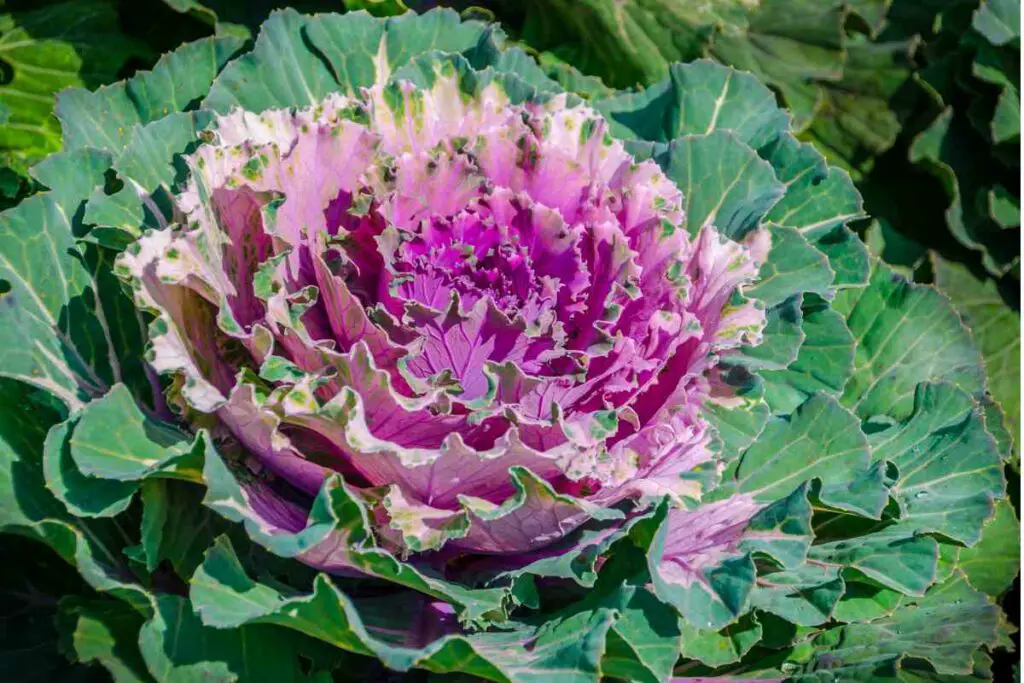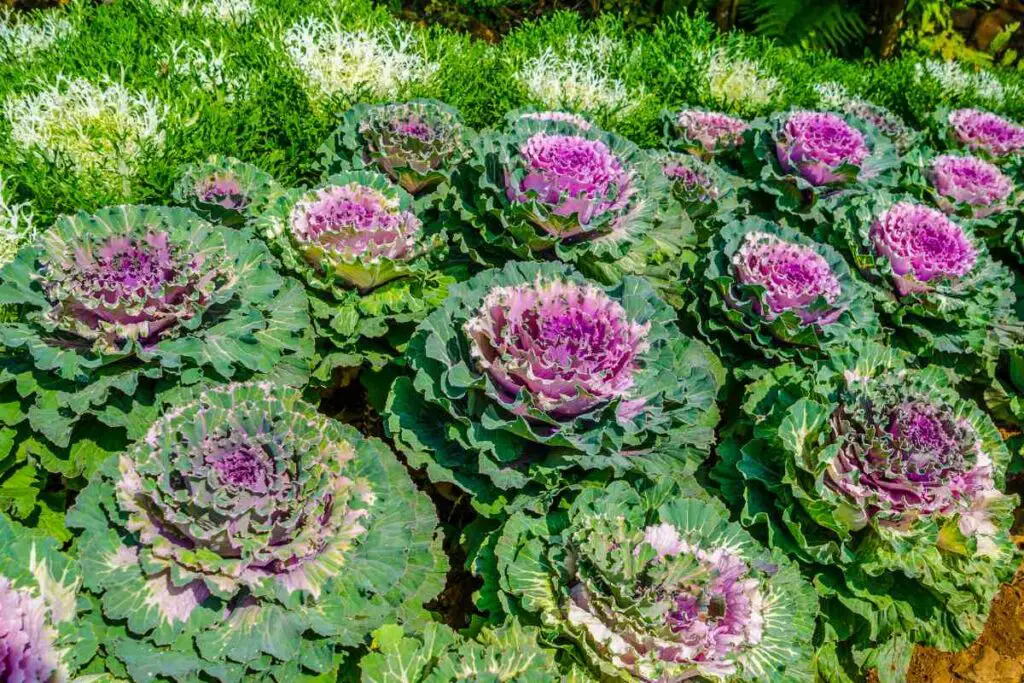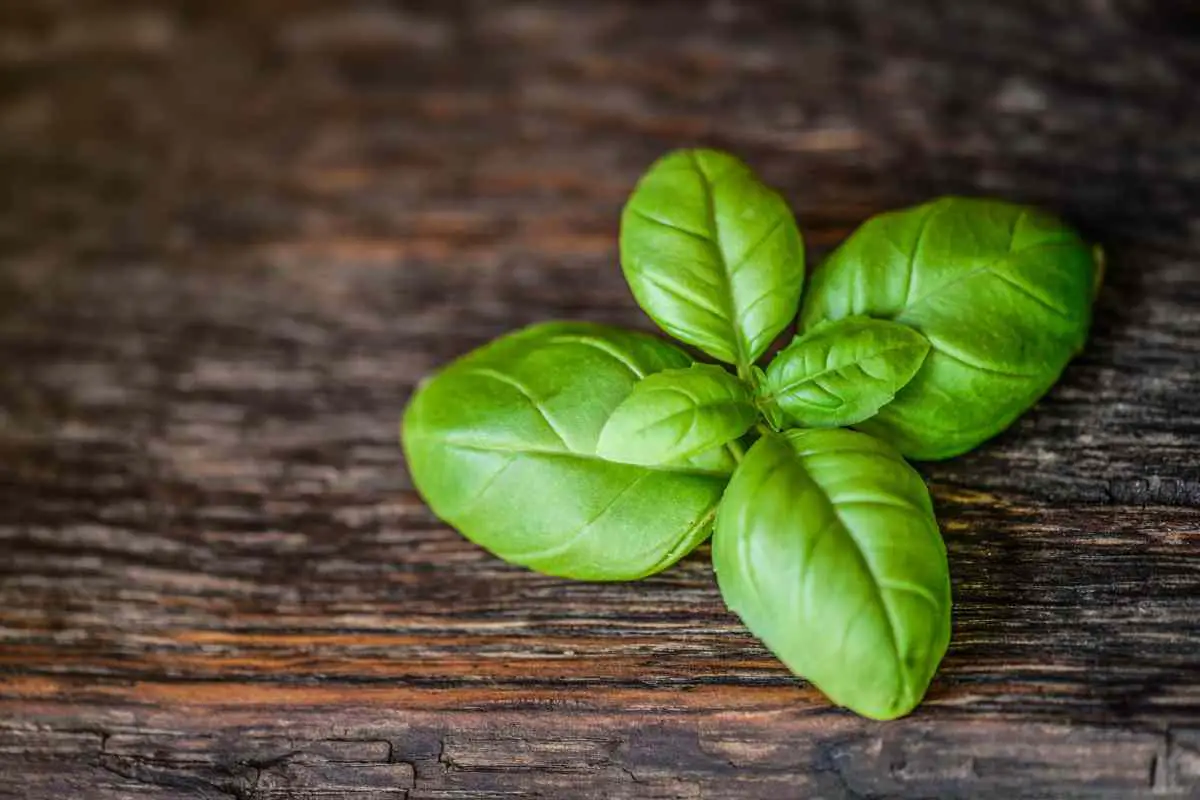Ornamental cabbage and kale are a unique and beautiful addition to any garden. These leafy greens come in a variety of colors, including shades of white, pink, purple, and green, and add a pop of color to any landscape.
Not only are they visually stunning, but they are also easy to grow and care for.

In this article, we will provide tips and tricks for growing ornamental cabbage and kale in your own garden.
Table of Contents
Step-by-Step Guide: How To Grow Ornamental Cabbage and Kale
Ornamental cabbage and kale are cool-season annuals, meaning they thrive in cooler temperatures and will typically last through the winter in most climates.
Here is our Step-by-Step guide for growing these beautiful leafy greens:
- Choose a location that receives full sun to partial shade. These plants can tolerate a wide range of light conditions, but they will grow best in a location that gets at least 6 hours of sunlight per day.
- Prepare the soil by adding compost or well-rotted manure to improve drainage and fertility. These plants prefer rich, well-draining soil.
- Sow the seeds directly in the ground in late summer or early fall, or start them indoors about 6-8 weeks before the last frost date in your area. If starting indoors, use seedling trays or pots filled with seed starting mix and keep the soil moist until the seeds germinate.
- Thin the seedlings to about 8-12 inches apart once they have developed their first set of true leaves.
- Water the plants regularly, making sure to keep the soil consistently moist but not waterlogged.
- Fertilize the plants once a month with a balanced fertilizer, such as a 10-10-10 formula.
- Protect the plants from extreme cold by covering them with a frost blanket or bringing them indoors if temperatures are expected to drop below freezing.
With proper care, ornamental cabbage and kale will thrive in your garden and add a splash of color to your landscape.
Tips for Maintaining Growth of Your Ornamental Cabbage and Kale
Here are some tips for maintaining the growth of your ornamental cabbage and kale plants:
- Keep the soil moist but not waterlogged. These plants prefer consistently moist soil, but they do not tolerate standing water.
- Fertilize the plants once a month with a balanced fertilizer, such as a 10-10-10 formula. This will help to keep the plants healthy and encourage growth.
- Remove any damaged or diseased leaves as soon as you notice them. This will help to prevent the spread of any problems to the rest of the plant.
- Pinch off any flowers that appear. While ornamental cabbage and kale are grown primarily for their colorful leaves, they may produce small, inconspicuous flowers. Pinching off the flowers will help to redirect the plant’s energy into leaf production.
- Protect the plants from extreme cold. Cover them with a frost blanket or bring them indoors if temperatures are expected to drop below freezing.
By following these tips, you can help to ensure that your ornamental cabbage and kale plants continue to thrive and add beauty to your garden.
Best Fertilizer To Use For Ornamental Cabbage and Kale Plants
A balanced fertilizer is typically the best choice for ornamental cabbage and kale. A balanced fertilizer has equal amounts of nitrogen, phosphorus, and potassium, such as a 10-10-10 formula.
Nitrogen promotes leaf growth, phosphorus helps with root development and flower production, and potassium helps with overall plant health and disease resistance.
You can also use an all-purpose, water-soluble fertilizer that is formulated for use on flowers. Follow the instructions on the fertilizer label for the recommended amount to use and frequency of application.
- Size: 5 LB
- Uniform, homogenous granular formulation .
- CONTAINS: 10% Nitrogen, 10% Phosphorus (P205), 10% Potassium (K20) plus minor elements .
- APPLICATION: Broadcast evenly over area and water in.
- For large quantity discount consideration or to request a mixed multi-pack, please message
Prices pulled from the Amazon Product Advertising API on:
Product prices and availability are accurate as of the date/time indicated and are subject to change. Any price and availability information displayed on [relevant Amazon Site(s), as applicable] at the time of purchase will apply to the purchase of this product.
It is important to avoid over-fertilizing, as this can lead to excessive leaf growth at the expense of flowers and can also cause the plants to be more prone to pests and diseases.
Always use fertilizers according to the instructions on the label and be sure to water the plants well after applying fertilizer to help prevent root burn.
Temperature and Environment To Grow Cabbage and Kale
Ornamental cabbage and kale are cool-season annuals, which means they thrive in cool temperatures and will typically last through the winter in most climates.
They can tolerate a wide range of light conditions, but they will grow best in a location that receives full sun to partial shade and gets at least 6 hours of sunlight per day.
These plants prefer rich, well-draining soil and should be watered regularly to keep the soil consistently moist but not waterlogged. They will benefit from the addition of compost or well-rotted manure to improve the soil’s drainage and fertility.
It is important to protect ornamental cabbage and kale from extreme cold, as they are not frost-tolerant. Cover the plants with a frost blanket or bring them indoors if temperatures are expected to drop below freezing.
In general, ornamental cabbage and kale are easy to grow and care for, and they make a beautiful addition to any garden. With proper care, they will thrive and add a splash of color to your landscape.

What Do Ornamental Cabbage and Kale Plants Look Like?
Ornamental cabbage and kale are leafy greens that are grown primarily for their colorful leaves. The leaves of these plants come in a variety of shades, including white, pink, purple, and green.
They are large, ruffled, and deeply lobed, and they can add a unique and beautiful texture to a garden bed or container.
The plants themselves are typically compact and bushy, growing to a height of about 12-18 inches. They may produce small, inconspicuous flowers, but they are grown primarily for their colorful leaves.
Ornamental cabbage and kale are often used as bedding plants or in container gardens, and they can also be used in cut flower arrangements. They add a pop of color to any landscape and can brighten up a garden in the cooler months.
How To Protect Ornamental Cabbage and Kale Plants From Pests?
There are several steps you can take to protect your ornamental cabbage and kale plants from pests:
- Keep the plants well-watered and fertilized. Healthy plants are less prone to pest problems.
- Remove any damaged or diseased leaves from the plants. This will help to prevent the spread of any problems to the rest of the plant.
- Avoid applying pesticides unless absolutely necessary. Pesticides can be harmful to beneficial insects, such as pollinators, and may also harm the plants themselves.
- Use natural pest control methods whenever possible. For example, you can use companion planting to deter pests by planting pest-repelling plants near your ornamental cabbage and kale.
- Keep the area around the plants clean and free of debris. This will help to prevent pests from taking up residence near your plants.
By following these tips, you can help to prevent pests from becoming a problem in your ornamental cabbage and kale plants. If you do notice a pest problem, try to identify the pest and take appropriate action, such as removing the pests by hand or using a natural pest control method.
Can Ornamental Cabbages and Kale Plants Survive Through Winter?
Ornamental cabbage and kale are not frost-tolerant and can be damaged or killed by extreme cold.
To help your ornamental cabbage and kale plants survive through the winter, it is important to protect them from extreme cold.
Cover the plants with a frost blanket or bring them indoors if temperatures are expected to drop below freezing. You can also mulch around the base of the plants to help insulate the soil and protect the roots.
In general, ornamental cabbage and kale are hardy plants that are well-suited to cooler weather. With proper care and protection from extreme cold, they can thrive and add beauty to your garden throughout the winter months.
Conclusion
In conclusion, growing ornamental cabbage and kale can add a unique and beautiful touch to any garden.
These leafy greens come in a variety of colors and add a pop of color to any landscape. They are easy to grow and care for, and they prefer cooler temperatures, making them a great choice for gardens in cooler climates. In addition to their visual appeal, ornamental cabbage and kale are also low maintenance and can help to brighten up a garden during the cooler months.
Overall, these plants are a wonderful addition to any garden and can bring joy and beauty to any landscape.
- How to Build a Planter Box for Bamboo: A Step-by-Step Guide

- Can Robotic Lawnmowers Handle Steep Slopes?

- Do You Need a Specific Lawn for a Robotic Lawnmower? Expert Advice

- Are Robotic Lawnmowers Safe for Pets and Children? Safety Features of Robotic Lawnmowers

- Why Use Robotic Lawnmowers? Advantages of Using a Robotic Lawnmower

- Is the GARDENA SILENO City 300 Cordless or Corded? A Clear Answer















